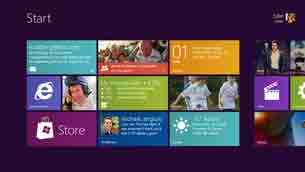News
Microsoft Demos Windows 8 at D9 Conference
Microsoft finally revealed some details about the operating system today known by its code-name "Windows 8," demoing it for attendees at the D9 Conference on Wednesday evening.
Most notable about Windows 8 is the new user interface, which takes its cue from the live tiles metaphor featured on Windows Phone 7. Gone is the ubiquitous Windows Start and the familiar desktop and icons UI. Instead, users get a start screen with so-called "live tiles" that show updated information from running apps. One of the tiles connects to a store to get apps.
The new OS will support applications that currently run on Windows 7, and users will see that same familiar Windows 7 interface for those apps. In addition, Microsoft is pushing a new paradigm for Windows 8 apps, which can be built based on HTML 5 and JavaScript. Those Windows 8 applications will be optimized for a touch-screen user interface, and other device-based sensors, although keyboard and mouse inputs will also work, according to Microsoft. Forrester Research analyst Sarah Rotman Epps describes this approach as a "touch first" emphasis for developers. Windows 7 supports touch, but it lags somewhat in current tablet designs, she indicated.
 [Click on image for larger view.] [Click on image for larger view.] |
| The Windows 8 start screen uses a tile-based UI approach, like the Windows Phone 7 OS. |
In a press release, Microsoft described new libraries and controls for developers "designed for fluid interaction and seamless connectivity." For instance, the file picker control can be used to get info from an independent software vendor's application or from another Windows 8 application, and also tap the "local file system and the network."
Microsoft also announced on Wednesday that it has created a new Build developer conference, scheduled for September 13 to 16, 2011 in Anaheim, Calif. Build will supersede the Microsoft's traditional Professional Developers Conference, according to veteran Microsoft reporter Mary-Jo Foley.
Steven Sinofsky, president of Microsoft's Windows and Windows Live Division, told All Things Digital reporter Ina Fried that Microsoft had been planning the new OS ever since Windows 7's completion in July 2009 and that Microsoft was "influenced" by mobile phones in creating Windows 8. Sinofsky, along with Julie Larson-Green, corporate vice president for the Windows experience, told D9 Conference hosts and journalists Walt Mossberg and Kara Swisher that Windows 8 represents the biggest Windows change since Windows 95, according to a transcript.
As noted in January at the Computer Electronics Show, Microsoft has designed Windows 8 to run on system-on-chip architectures, including x86 (AMD, Intel) and ARM Holdings designs. Chip partners include AMD, Intel, Nvidia, Qualcomm and Texas Instruments. It's thought that Windows 8 on ARM chips will open up new possibilities for low-power devices with different form factors. However, it's not clear if current Windows 7 applications will be easily ported to the new ARM-based hardware. Intel last month raised questions on that point, but Microsoft objected that Intel's comments were inaccurate and misleading.
Microsoft has not yet said when Windows 8 will appear on the market. CEO Steve Ballmer dropped the year 2012 for Windows 8's release, but Microsoft spokespersons later characterized his comment as a "misstatement." Epps suggested that if Microsoft can get Windows 8 to market in 2012, it will "stave off defection from OEM partners to alternative operating systems, and from consumers and enterprises tempted by Apple's platform."
Microsoft's bloggers have just gotten started sending out additional information about Windows 8. For a summary thus far, check out this Microsoft blog. Information on Microsoft's new upcoming Build conference for developers can be found here, where registration is currently open.
Microsoft describes Windows 8 in greater detail in this video.
About the Author
Kurt Mackie is senior news producer for 1105 Media's Converge360 group.